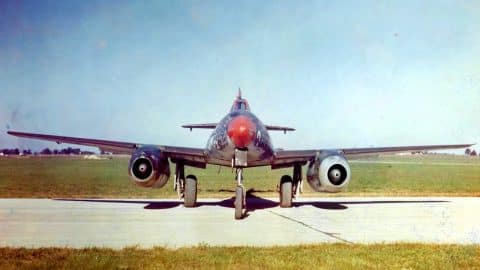
YouTube / Dark Docs
By the time the Allies stormed the beaches of Normandy on June 6, 1944, the Air Force’s Air Technical Intelligence had already compiled lists of Luftwaffe aircraft they sought to inspect and learn from in the future. These aircraft were included in the “Black Lists.”
The Air Technical Intelligence teams were trained at Wright Field, Ohio, racing against other intel groups to gather information on enemy aircraft and components from crash sites and captured airfields.

However, the most desirable aircraft on the list was still the world’s first operational jet fighter – the Me-262.
On April 22, 1945, the USAAF merged its intelligence teams to join forces in Operation Lusty, an acronym for Luftwaffe Secret Technology.

The operation was composed of two teams: one led by Col. Harold E. Watson, and the other by Col. Howard McCoy. Watson’s team focused on collecting Luftwaffe aircraft and weapons, while McCoy’s aimed to capture scientists, classified documents, and investigate aircraft facilities.
Watson began recruiting Luftwaffe pilots like Robert Strobell to teach his fellow airmen to operate and maintain captured aircraft.

After Germany’s surrender in May 1945, Strobell was able to fly directly to Lechfeld, Augsburg, where several Me-262s had been captured. Aside from the jet fighter, Watson’s team was also able to procure the Bf-109, Fw-190, He-177, Ju-388, Ju-290, and Ar-234.
After inspections and a new fresh set of paint, the team started testing the true capabilities of the Me-262. As they’d expected, their tests showed that the aircraft was smooth, powerful, and extraordinarily fast.

The US pilots flew the captured 262s to Melun on June 10, 1945. Once there, Watson informed Strobell that General Carl Spaatz, Chief of the Army Air Forces in Europe, wanted the team to showcase the power of the 262 during a special event.
It took place on June 27, with the pilots performing a series of mid to low-level passes and various maneuvers. During the final pass, Strobell nailed a vertical barrel roll which impressed General Spaatz who was quoted saying:
“Hal (Watson), that’s a wicked airplane! I’m sure glad the Germans screwed up the tactical use.”

Ultimately, Operation Lusty was extremely successful thanks to the extraordinary effort of Watson’s team. Over 16,300 items or 6,200 tons were captured and inspected by technicians of the Army Air Forces Intelligence.